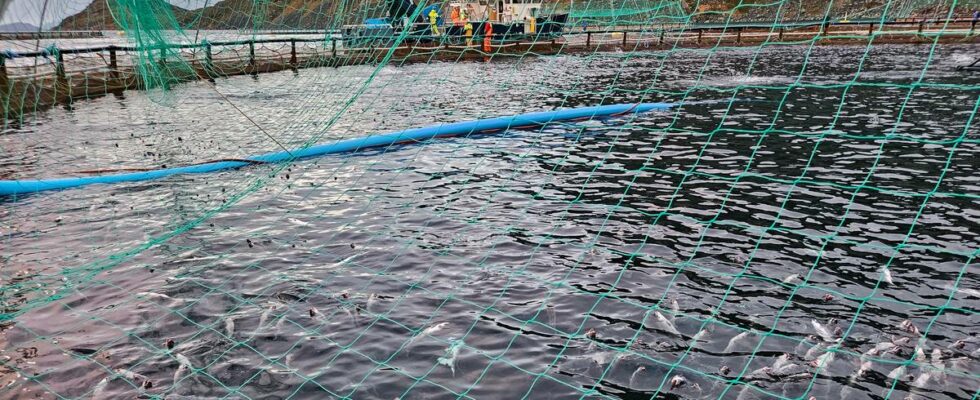The case in summary: 126,242 farmed fish have died after pearl normanets have arrived at Grieg Seafood’s Vinnalandet site in Vest-Finnmark. Cermaq has also lost between 2,000 and 4,000 fish after the poisonous jellyfish came to their facility in Hamnefjord. The Norwegian Food Safety Authority describes the situation as very challenging, and says it is important to have good contingency plans. The Institute of Marine Research is now working on training artificial intelligence, with a particular focus on the pearl jellyfish, in order to be able to warn earlier when the jellyfish will arrive. Over the course of three and a half weeks, Grieg Seafood has recorded 126,242 dead fish at the Vinnalandet location in Western Finnmark due to large infestations of pearl seabream. – The numbers of fish that have been affected and taken up, after we got the pearl standard in the facility, are constantly developing, depending on the status of the jellyfish infestation. This is what media contact Roger Pedersen at Grieg Seafood tells the online newspaper iLaks.no, which reported on the case first. The company notified the Norwegian Food Safety Authority on 1 November about the poisonous jellyfish, which can be fatal to farmed fish. They have seen strong behavioral changes in the fish at the breeding facility at Hammerfest. Photo: Norwegian Food Safety Authority Desperate situation Geir Arne Ystmark, head of aquaculture in the Norwegian Food Safety Authority, describes the situation as very challenging. – Those who are hit hard quickly end up in a desperate situation, he says to news. It is not only Grieg Seafood’s facility in the Vinnasundet that has been visited by the poisonous jellyfish. Cermaq’s breeding facility in Hamnefjord is also affected. – Perlesnormanet “hit” several localities in Sørøysundet at the weekend. The locality has been hit hard, says Ystmark. Perlesnormanet, as the name suggests, looks like pearls on a string. It is a so-called colony jellyfish, and last year it killed 3 million farmed fish. Photo: Erling Svensen / Marine Research Institute Astrid Aam, communications manager at Cermaq, says that they have also seen pearl normanets at Kraken, Slettnes and Husfjord. At these plants, the situation is better than at Hamnefjord, reports iLaks. – In the most affected cages, we have a number of fish standing high in the water, which complicates the work of removing dead fish, but we estimate that we have between 500 and 1,000 dead fish in each of the four cages that are most affected of the Perlesnormanets, she says of Hamnefjord. Ystmark says that good contingency plans must be in place when the jellyfish move in. In addition, it is important to have enough capacity so that the breeding facilities can handle larger quantities of dead fish, sort out damaged fish and, in the worst case, destroy entire cages. – What we see from the inspections is that a lot of fish are affected, and that the business is working hard to deal with the situation. Know little about the jellyfish According to the Institute of Marine Research (HI), for the past three years jellyfish have been observed along the coast as winter approaches, with a peak in November and December, before the observations taper off in January. Marine researcher Tone Falkenhaug warns in the channels they can to warn against the intrusion of pearl normanets. Even if the warnings reach, there is not much that can be done with these jellyfish if they first come close to the cages. Marine researcher Tone Falkenhaug says that we know quite a bit about the Perlesnormanet. Photo: Erlend Astad Lorentzen / Institute of Marine Research – There is so much we don’t know about this jellyfish. We don’t even know what species it is, says Falkenhaug. Last year, farm after farm was visited by the jellyfish. Around 3 million farmed fish will probably die as a result of jellyfish attacks in 2023. Facts about the pearl jellyfish Latin name: Apolemia uvaria Is a so-called colony jellyfish that can grow up to 30 m long and is a few cm thick. It looks like a pearl necklace. Belongs to the nettles (cnidaria), and has strong nettle venom that can harm fish. The colony is pelagic and drifts with the ocean currents, and can occur throughout the water column from the surface to a depth of 1,000 metres. The species is widespread in the Pacific, Mediterranean and Atlantic oceans. Previous reports from blooms in 1997 and 2001 indicate that the jellyfish occur in highest concentrations at the far end of the coast. Source: Institute of Marine Research Trainee KI Roger Pedersen at Grieg Seafood informs iLaks.no that they have and have had close cooperation with the Norwegian Food Safety Authority. – We follow fixed procedures where we report the status to the Norwegian Food Safety Authority on an ongoing basis. When there are incidents in facilities and we report increased mortality, this happens in collaboration with the Norwegian Food Safety Authority, says Pedersen. The bottom of one of Grieg Seafood’s cages. Dead fish and fainters lie at the bottom, and more fainters are about to fall down. Photo: The Norwegian Food Safety Authority HI is now working to find solutions that can enable breeders along the coast to receive early notices if pearled normans are on their way to their locations. They work on training artificial intelligence, with a particular focus on the pearl standards. – Perlesnormanetes is very characteristic, so it should be relatively easy to train the artificial intelligence model to recognize it, says marine researcher Mats Huserbråten. His next project is to develop a self-propelled underwater drone that can detect pearl norman along the coast. Published 21.11.2024, at 15.17
ttn-69
Over 125,000 farmed salmon died in Finnmark from perlesnormanet – news Troms and Finnmark

